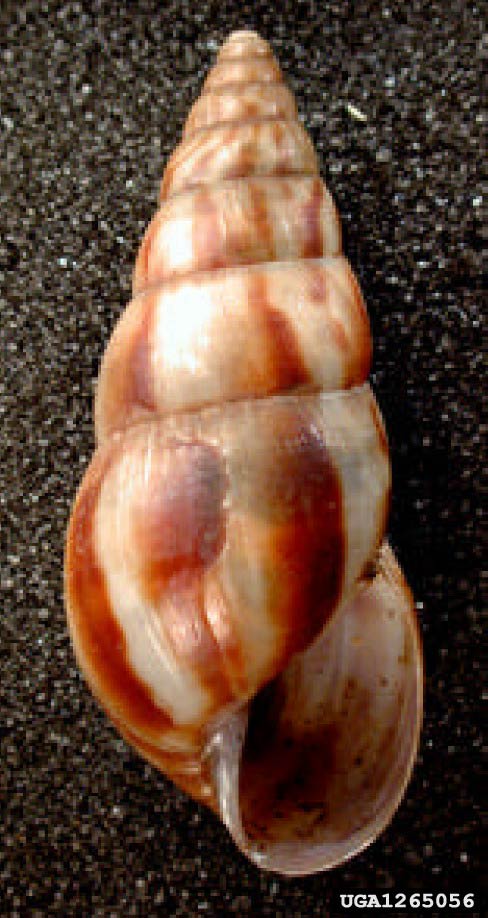Limicolaria aurora
Family
Achatinidae
Species
Limicolaria aurora (Jay, 1839)
Common name
escargot Geant d'Afrique, Nigerian land snail
Description
This snail generally attains a heightHeight:
The height of the shell is a measure of the distance between the apex and the most basal part of the shell OR the measurement taken from the apex of the shell to the base, when measured parallel to the axis of the shell.
of 60 mm and a widthWidth:
The width of the shell is the maximum distance across the shell (including the aperture).
of 28 mm, with 9-9.5 whorlsWhorls:
Pleural of whorl. A whorl is a complete spiral turn/growth of the shell of a mollusc. The whorls are counted from the apex outwards.
at maturity. The shellShell:
A hard, inflexible, calcareous or chitinous structure that vary in size and may either completely encasing the animal, covering some part of it or be internal.
is smooth, dull, oblong-ovate and displays a wide range of colors. The umbilicusUmbilicus:
A navel-like indentation or depression in the center of the shell. It may be described as open (inside of columella visible), partially closed (partly covered by base of aperture) or completely closed (not visible). The width of the umbilicus is a measure of its greatest diameter.
(navel) is narrow.
Native range
East Africa
Distribution
North America: Currently not present, though it is commonly intercepted at U.S. ports
Caribbean: Martinique
Africa: West: Guinea to Nigeria, Cameroun and Gabon
Ecology
Achatinids are generally nocturnalNocturnal:
Occurring or becoming active at night.
forest dwellers but have the potential to adapt to disturbed habitats. Concealed habitats are generally preferred; however, individuals may colonize more open habitats in the event of overcrowding. Achatinids often become more active during periods of high humidity (e.g., after rainfall); however, the occurrence of large numbers of individuals especially during daylight may indicate high population density.
Achatinids are hermaphroditicHermaphroditic:
State of having both male and female reproductive organs. (See also Hermaphrodite)
and there the introduction of a single mature specimen, into a new habitat, can initiate a new population. Achatinids normally lay their calcareousCalcareous:
Consisting of limestone or calcium carbonate.
eggs in the soil, but they may be deposited under leaf litter or rocks. They feed on both living and dead plant material. In addition to being agricultural pests, achatinids can be a threat to public health as they act as a reservoir host of the rat lung parasites (Angiostrongylus cantonensis and A. costaricensis), which causes eosinophilic meningoencephalitis in humans. They can also be an unsightly public nuisance during periods of population explosion.
This species of Achatinid (Limicolaria aurora) has the potential to reproduce in much drier conditions than other species. The eggs are often laid in the soil and have an incubation period of approximately 30 days. This species has been reported to consume the following plants: oil palm, yam (Dioscorea alata), black pepper, Jerusalem artichoke, cucumber, okra, rose-mallow, sweet potato and legumes.
Synonyms
None
References
Abbott 1989Abbott 1989:
Abbott, R.T. 1989. Compendium of landshells. A full-color guide to more than 2,000 of the World’s terrestrial shells. American Malacologists, Inc., Melbourne, FL and Burlington, MA. pp. 240.; Barker 2002Barker 2002:
Barker, G.M. (Ed.) 2002. Molluscs as crop pests. CABI Publishing, Wallingford, UK. pp. 1-468.; Ebenso 2006Ebenso 2006:
Ebenso, I.E. 2006. A note on the effect of water on incubating eggs of edible tropical land snail Limicolaria aurora. Livestock Research for Rural Development 18: Article 150.; Cowie et al. 2009; Udoh et al. 1995Udoh et al. 1995:
Udoh, A.P., E.O. Akpanyung and I.E. Igiran. 1995. Nutrients and anti-nutrients in small snails (Limicolaria aurora). Food Chemistry 53: 239-241.


